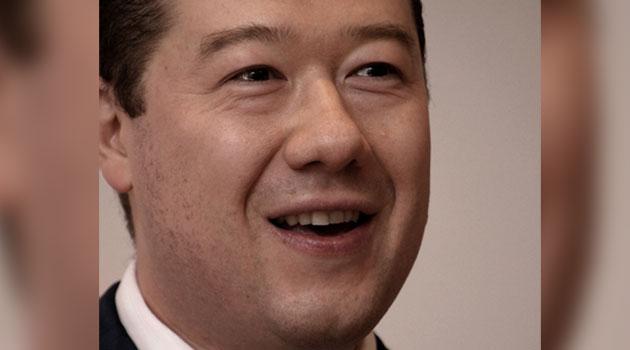Czech Human Rights Minister for Human Rights, Equal Opportunities and Legislation Jiří Dienstbier (Czech Social Democratic Party – ČSSD) is convinced that Czech MP Tomio Okamura, the head of the "Dawn of Direct Democracy" movement (Úsvit) must resign from all of his political offices because of his controversial remarks about the Lety concentration camp. Czech Prime Minister Bohuslav Sobotka (ČSSD) said he believes Okamura is using the language of Protectorate propaganda from before 1945.
Czech MP Miroslav Kalousek (TOP 09), who is his party’s vice-chair, said he considers Okamura’s words to be "the kind of moral turpitude that rises to the level of a felony". Okamura claimed to be surprised today by the wave of displeasure sparked by his remarks and has toned them down, but is neither apologizing for them nor recanting them.
One of those who was displeased was the Prime Minister. "I believe Mr Okamura’s statements are very unfortunate. He is using the language of Protectorate propaganda from before 1945 and denying historical facts," Sobotka said, adding that historical research has demonstrated that Romani people fell victim to the Holocaust in addition to Jewish people.
"There were concentration camps on the territory of the Protectorate that were not labor camps but that essentially were intended to serve the purpose of exterminating the Romani people who were transported there from all over the entire territory of the Protectorate and a large proportion of those people ultimately ended up in the extermination camps in Poland, particularly in Auschwitz," Sobotka noted. The PM went on to say that as an MP and as Prime Minister it would be difficult for him to avoid meeting with democratically elected opposition MPs.
"Denying any genocide, or belittling or relativizing one, is the kind of moral turpitude that rises to the level of a felony, and it is exceedingly dangerous for democracy, it must definitely be rejected," said Czech MP Kalousek. "Mr Okamura is reaching out to his followers, they elected him, which is a sad fact of Czech politics."
Okamura stated, among other things, that "the myth of a Romani concentration camp is a lie, according to the available information." He said he believed Lety was a labor camp for persons who were avoiding proper work.
"No one was killed at the camp – people died there as a result of old age and the diseases they brought with them as a result of their previous travelling lifestyle," he said, adding that the victims of the Lety camp were definitely not Holocaust victims. "On the contrary, comparing them to Holocaust victims disrespects the actual victims of the Holocaust, whether they be Jews or Roma, who perished in the real concentration camps," Okamura said.
Czech President Miloš Zeman responded to Okamura’s remarks today through his spokesperson, Jiří Ovčáček, who said said that if Lety had been a labor camp, its prisoners would not have ended up in Auschwitz. News server Romea.cz has also published some of the recollections of the former prisoners in an article today .
Okamura claimed to have been surprised by the reaction from other politicians to his remarks and released a new statement on the matter today, claiming that he has never for one second doubted the worngs committed at Lety. He claimed his initial statement did not concern the crimes committed against those who were transported from Lety to other concentration camps – "The Romani Holocaust is terrible and the camp at Lety was criminal," he has now said.
The history of the concentration camp at Lety
The original space at Lety served in 1940 as an accommodation facility for construction workers. Subsequently, a disciplinary labor camp was created there on the orders of the Interior Minister of the Protectorate Government, Josef Ježek, on 15 July 1940, issued on the basis of Government Decree No. 72 on disciplinary labor camps dated 2 March 1939.
That particular decree had been issued prior to the country being occupied by the Nazis. According to the decree, "wandering gypsies and other vagrants living in the same way who are capable of work, beggars by trade and those who make a living from begging (children, etc.), gamblers by trade, inveterate idlers, loafers and persons making a living from dishonest earnings (prostitution, etc.), whether their own or those of others" were to be rounded up and concentrated in particular facilities.
The first 12 prisoners arrived at Lety on 17 July 1940. On 1 August 1942 the camp was changed into a "Gypsy camp" and subsequently entire Romani families were transported there.
The concentration camp began running on 1 August 1942 and was closed on 4 May 1943. Its capacity was increased to accommodate up to 600 prisoners, but that number was soon exceeded, as during the course of August 1942 more than 1 100 children, men and women were interned in the camp.
The camp was not equipped with the necessary hygienic or other facilities for such a large number of people. The prisoners often had to bathe in a nearby fishpond.
Until August 1942, only men were imprisoned at Lety. After that, children and women were also brought there to rot in completely unsatisfactory conditions.
After the big influx of August 1942, whole families were mostly brought to the camp as well as individuals. A total of 326 people died directly in the Lety camp, 241 of them children.
A temporary burial ground near the camp was used to inter 120 victims. Another 540 prisoners from Lety perished while being transported to Auschwitz.
A total of two mass transports were undertaken. The first one departed on 3 December 1942 as a transport of so-called asocials, 16 men and 78 women, to the Auschwitz I concentration camp.
The second transport practically meant the liquidation of the Lety camp, as it included 417 prisoners who went to the Auschwitz II-Birkenau concentration camp. While the first transport took place on the basis of a decree about crime prevention, the second took place on the basis of Himmler’s decree of 16 December 1942, which ordered the transport of all Romani people to the Auschwitz concentration camp.
The remaining 198 prisoners were then relocated to the "gypsy camp" at Hodonín near Kunštát (the so-called Žalov camp) or were interned in camps in Pardubice and Prague. On 13 May 1995, at the site of the mass grave next to the former camp, a memorial was unveiled with the inscription "To the victims of the gypsy camp at Lety 1942-1943. Never forget. Ma bisteren."
On 13 May 2010 the Lety Memorial was officially opened there. A government decision has entrusted the Lidice Memorial with its management.

